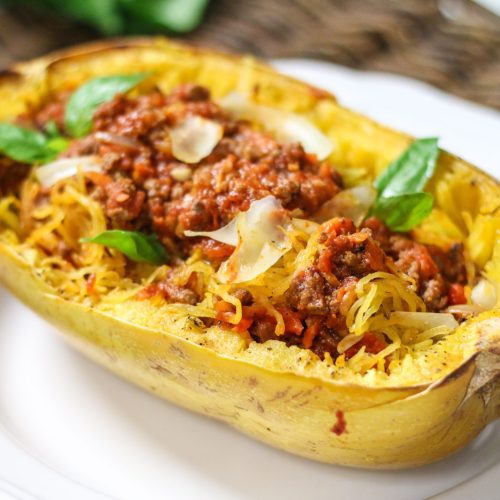
Spaghetti Squash Recipe
Hey foodies, are you looking for a nutritious alternative to traditional pasta? Look no further than spaghetti squash recipe! This vibrant and versatile vegetable offers a delightful way to enjoy a classic pasta dish while boosting your veggie intake. In this article, we’ll explore the origins of spaghetti squash, provide a step-by-step guide to preparing it, share its nutritional benefits, and answer ten frequently asked questions. Let’s dive in!
History and Origin:
Spaghetti squash, scientifically known as Cucurbita pepo, is believed to have originated in Central America. It has been cultivated for centuries and was introduced to Europe and North America by explorers in the 15th and 16th centuries. While its exact origins are unclear, spaghetti squash has become a beloved ingredient in many cuisines around the world.

Spaghetti Squash Recipe
Equipment
- Sharp knife
- Spoon
- Baking sheet
- Fork
Ingredients
- 1 medium spaghetti squash
- Olive oil
- Salt and pepper to taste
- Optional toppings: marinara sauce, grated cheese, fresh herbs
Instructions
- Preheat your oven to 375°F (190°C).
- Wash the spaghetti squash thoroughly and pat it dry.
- Carefully slice the squash in half lengthwise using a sharp knife.
- Scoop out the seeds and fibrous strands from the center using a spoon.
- Drizzle olive oil over the cut sides of the squash and season with salt and pepper.
- Place the squash halves, cut side down, on a baking sheet lined with parchment paper or aluminum foil.
- Bake in the preheated oven for 35-45 minutes, or until the flesh is tender and easily pierced with a fork.
- Remove the squash from the oven and let it cool for a few minutes.
- Using a fork, scrape the flesh of the squash to create long strands resembling spaghetti.
- Serve the spaghetti squash hot with your favorite toppings, such as marinara sauce, grated cheese, or fresh herbs.
Video
Similar Recipes
– Spaghetti Squash Carbonara: Toss cooked spaghetti squash with crispy bacon, eggs, Parmesan cheese, and black pepper for a decadent twist on the classic carbonara.
– Spaghetti Squash Pad Thai: Stir-fry cooked spaghetti squash with vegetables, tofu or chicken, and a flavorful pad Thai sauce for a nutritious and satisfying meal.
Frequently Asked Questions (FAQs) About Spaghetti Squash Recipe:
1. Can I microwave spaghetti squash instead of baking it?
Yes, you can microwave spaghetti squash. Simply pierce the whole squash with a fork, microwave on high for 10-12 minutes, and then proceed to scrape out the cooked flesh.
2. How do I store leftover spaghetti squash?
Store cooked spaghetti squash in an airtight container in the refrigerator for up to 3-4 days.
3. Can I freeze cooked spaghetti squash?
Yes, you can freeze cooked spaghetti squash. Place it in a freezer-safe container or bag and store it in the freezer for up to 2-3 months.
4. What can I do with spaghetti squash seeds?
You can roast spaghetti squash seeds, similar to pumpkin seeds. Simply rinse them, toss with olive oil and seasonings, and bake in the oven until golden brown and crispy.
5. Is spaghetti squash gluten-free?
Yes, spaghetti squash is naturally gluten-free, making it a suitable option for those with gluten intolerance or celiac disease.
6. Can I eat the skin of spaghetti squash?
While the skin of spaghetti squash is edible, it tends to be tough and is often discarded after cooking.
7. What are some creative ways to serve spaghetti squash?
Besides serving it as a pasta alternative, you can use spaghetti squash in casseroles, salads, soups, and even as a pizza crust.
8. Is spaghetti squash high in carbs?
Compared to traditional pasta, spaghetti squash is lower in carbohydrates, making it a popular choice for low-carb diets.
9. Can I use spaghetti squash in baking?
Yes, you can incorporate cooked spaghetti squash into baked goods like muffins, bread, and cakes for added moisture and nutrients.
10. Are there any health benefits associated with eating spaghetti squash?
Yes, spaghetti squash is rich in vitamins, minerals, and fiber, which can support digestive health, immunity, and overall well-being.
Conclusion:
Spaghetti squash offers a delicious and nutritious alternative to traditional pasta, and it’s easy to prepare with just a few simple steps. Whether you’re looking to lighten up your meals, increase your vegetable intake, or simply try something new, this versatile squash is sure to impress. So why not give it a try?
YouTube Video Credits:
Downshiftology

Leave a Reply